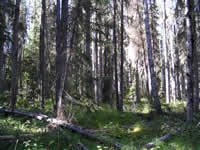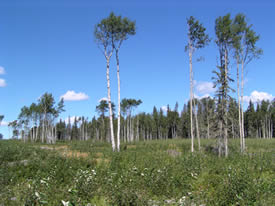Discussion of Cover Type Effect:
The results of the rarefaction analysis comparing cover types produced interesting insights which were consistently supported throughout the multivariate analyses. Upon initial interpretation of the rarefaction, there is a distinct difference in the abundances within the conifer and deciduous stands. Although this is partially a result of the greater number of replicates within the deciduous sites, this pattern is common within the boreal forest (Work et al., 2004; Jacobs et al., 2007). Within both cover types the observed higher species richness in the edge treatments compared to the intact forest was expected, and demonstrates the role of the edge as an ecotone between the forest and the clear-cut sites (Baker et al., 2007). This pattern also shows a definite edge effect at these sites, causing the increased estimated species richness. The trend of highest richness in the clear-cut treatment of the conifer stand type is typical of open habitat sites and was expected within the deciduous sites as well.
The multivariate analyses effectively highlighted both the extent of edge effects, and the impact of cover type on edge effects. The hierarchical clustering analysis again suggested a clear difference between the community compositions of deciduous and conifer dominated sites, a result which has been found in multiple studies (Work et al., 2004; Jacobs et al., 2007). The analysis also highlights that in both cover types the edge appears to be between 0 and 15 meters from the forest edge. The most interesting component of this analysis is where the 15 meter site breaks away from the clear-cut and 0 meter treatments of both cover types. Within the deciduous sites we see the 15 meter treatment grouping out initially with the other forest sites, suggesting a sharp contrast in composition between the 0 and 15 meter sites. Within the conifer however, this 15 meter site initially groups with the clear-cut and 0 meter sites and then quickly branches off. This suggests that within the conifer cover type the 15 meter trap may be an intermediary treatment, and that the edge may not penetrate as far within the conifer dominated sites due to this higher similarity. This pattern was confirmed with the NCAP analysis where the predicted edge in conifer dominated sites is closer to the forest edge than in the deciduous dominated sites. Thus there appears to be a slight difference between the extent of edge effects within the different cover types.
The NMS ordination provides more support to this observed pattern as within the deciduous cover type the 0 meter sites group much closer to the clear-cut treatments than in the conifer sites. In addition, the ordination demonstrates a clear difference between the conifer and deciduous clear-cut treatments. This pattern is opposite to what would be expected, as past studies have found a general loss of cover type effects within the clear-cut treatments (Work et al., 2004). This pattern may not have been found within this study because we sampled only two years after harvest and a lag in ground beetle community change may be a confound (Pohl et al., 2007). I am currently processing an additional years worth of data to further explore these observed patterns
This study demonstrates that the difference in community composition, which we commonly see between cover types, translates into a different degree of edge extent. Although this pattern was minimal, it will be better explored with data from a more intensive transect sampling protocol conducted over the past summer.

Discussion of Age Effect:
The initial exploration through rarefaction of the role of age on edge extent provided some univariate insights into the recovery of edge effects over time. The general pattern of higher species richness in the edge treatments when compared to the intact forest was consistent throughout both the 2 and 8 year old edge sites, however the pattern was lost within the 15 year old sites. The homogenization between the estimated species richness of the edge and intact forest sites in the 15 year old sites suggests that edge recovery may be occurring within 15 years of the edge creation.
This univariate pattern in community structure was well supported by the multivariate NCAP results. Here we saw abrupt changes in the community composition very close to the forest edge in both the 2 and 8 year old sites, which was no longer present in the 15 year old sites. Although the predicted depth of edge extent was much greater in the fifteen year old sites (65 meters), the 95 % confidence interval around this prediction extended the whole length of the transect. This high variability suggests that edge recovery is occurring within these 15 year old edges and the analysis was unable to determine a discrete location of the edge extent. These results imply that edge effects do exhibit signs of recovery when edges approach 15 years since harvest, however these preliminary results need to be interpreted with caution. The high degree of variability within this data set, which was discovered through the additional analyses section, suggests that more work needs to be conducted with this data set prior to drawing any major conclusions.

|